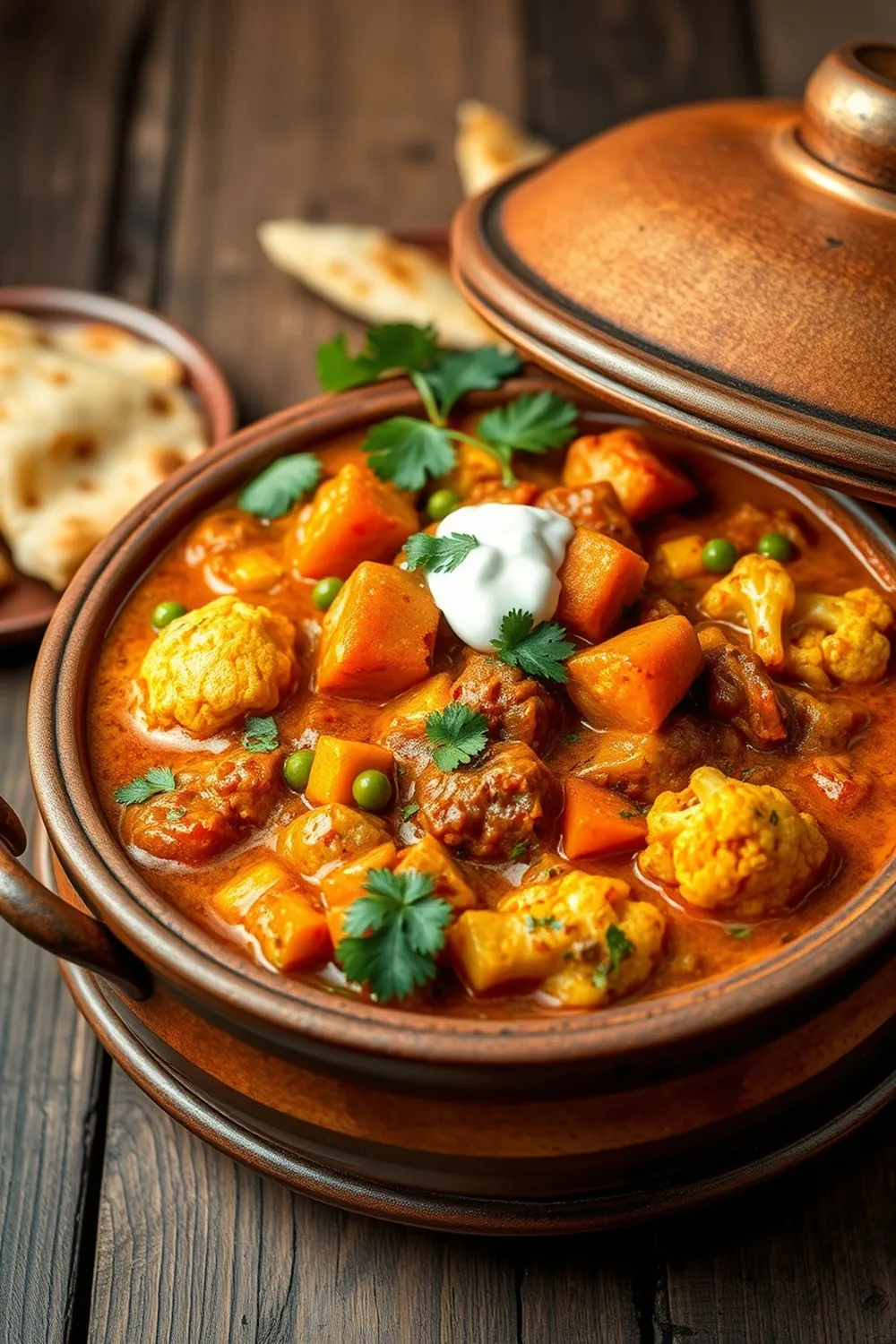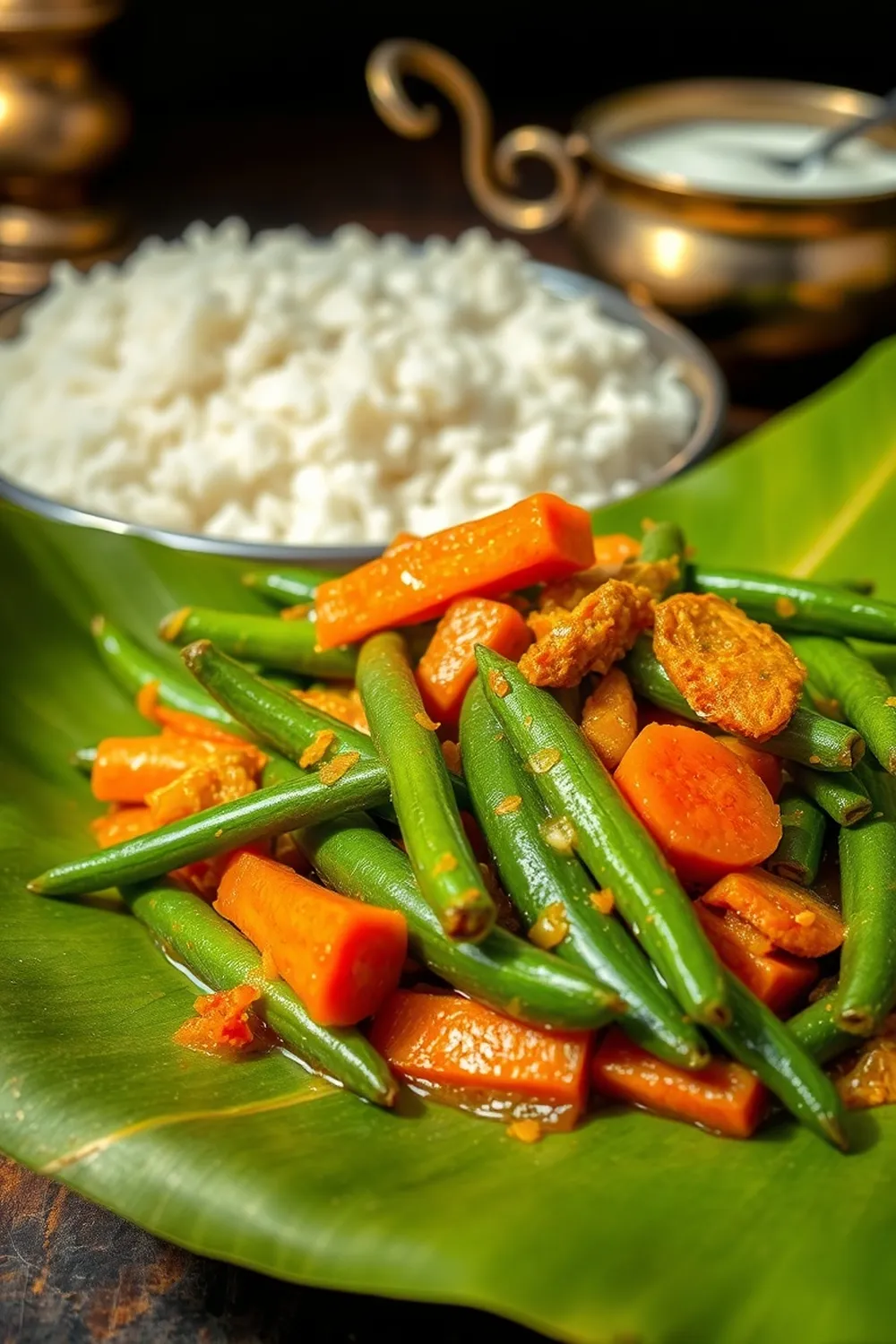- Heat 2 tsp oil in a kadai. Sauté chopped onions until translucent.
- Add ginger and garlic. Sauté until aromatic.
- Mix in tomatoes and cashews. Cook until tomatoes soften.
- Let the mixture cool, then blend into a smooth paste.
- In the same kadai, heat 2 tsp oil. Add bay leaf, cinnamon, and cloves. Sauté until fragrant.
- Stir in turmeric and red chili powder. Cook for 20 seconds.
- Pour in the blended onion-tomato paste. Cook for 2-3 minutes.
- Add coriander powder, cumin powder, and salt. Mix well.
- Whisk curd and add gradually while stirring continuously.
- Add chopped vegetables (carrot, cauliflower, capsicum, potato, peas, beans) and 2 cups water. Mix.
- Cover and simmer for 15 minutes or until vegetables are tender.
- Crush kasuri methi into the curry. Stir in cream and garam masala.
- Garnish with coriander leaves. Serve hot with naan or rice.
- Calories:450 kcal25%
- Energy:1882 kJ22%
- Protein:12 g28%
- Carbohydrates:45 mg40%
- Sugar:10 mg8%
- Salt:800 g25%
- Fat:25 g20%
Last Updated on 6 months ago by Neha Deshmukh
Vegetable Curry Recipe – Cashew Tomato & Creamy Indian Style
Introduction
There’s just something so comforting about a vibrant, flavorful vegetable curry, isn’t there? This one is a real family favorite – a creamy, dreamy mix of garden-fresh veggies simmered in a rich cashew-tomato gravy. I first made this when I was trying to recreate a dish my grandmother used to make, and after a few attempts, I think I finally got it just right! It’s perfect for a weeknight dinner, a special occasion, or even meal prepping for the week. Let’s dive in and make some magic!
Why You’ll Love This Recipe
This vegetable curry isn’t just delicious; it’s also wonderfully versatile. You can easily swap out the vegetables for whatever you have on hand, making it a great way to use up leftover produce. The cashew paste adds a beautiful creaminess without relying on heavy cream (though we do add a touch of that too – shhh!). Plus, the aromatic spices will fill your kitchen with the most incredible scent.
Ingredients
Here’s what you’ll need to create this delightful curry:
- 2 tsp oil
- 1 medium onion, roughly chopped (about 150g)
- 1 inch ginger, finely chopped
- 2 garlic cloves, roughly chopped
- 2 large tomatoes, finely chopped (about 400g)
- 7 cashews, whole (about 50g)
- 1 carrot, chopped
- 1 cup cauliflower florets (about 100g)
- 1 cup capsicum, thinly sliced (about 150g)
- 1 potato, cubed (about 150g)
- 1 cup peas (fresh or frozen)
- 5 beans, chopped (about 100g)
- 2 tsp oil
- 1 bay leaf
- 1 inch cinnamon stick
- 5 cloves
- 1 tsp turmeric powder
- 1 tsp Kashmiri red chili powder
- 1 tsp coriander powder
- 1 tsp cumin powder
- Salt to taste
- ½ cup curd (yogurt) – use full fat for best results!
- 2 cups water (500ml)
- 1 tsp kasuri methi, crushed
- 1 tbsp cream (malai)
- ½ tsp garam masala
- 2 tbsp coriander leaves, finely chopped
Ingredient Notes
Let’s talk ingredients! A few little tips from my kitchen to yours:
- Cashews & Their Role in Creaminess: Don’t skimp on the cashews! They are the secret to that luxurious, smooth texture. Soaking them in warm water for 10-15 minutes before blending will help create an even smoother paste.
- Kashmiri Red Chili Powder: Color & Flavor: This is a game-changer. It gives the curry a beautiful vibrant red color and a mild, fruity flavor. If you can’t find it, you can substitute with regular chili powder, but reduce the amount slightly as it can be spicier.
- The Significance of Kasuri Methi: Dried fenugreek leaves (kasuri methi) add a unique, slightly bitter aroma that’s essential in many Indian dishes. Crushing it between your palms releases its flavor.
- Vegetable Flexibility: Feel free to swap in other veggies like zucchini, mushrooms, or even spinach!
Regional Variations in Vegetable Curry
Vegetable curries are incredibly diverse across India. In South India, you might find coconut milk used for creaminess, while North Indian versions often feature more tomatoes and a richer gravy. Some regions add a touch of jaggery (gur) for sweetness. This recipe leans towards a North Indian style, but feel free to experiment and make it your own!
Step-By-Step Instructions
Alright, let’s get cooking!
- Heat 2 tsp oil in a kadai (or a deep pan) over medium heat. Add the chopped onions and sauté until they turn translucent and slightly golden.
- Add the chopped ginger and garlic. Sauté for another minute until fragrant – you should really start to smell those lovely aromas!
- Mix in the chopped tomatoes and cashews. Cook until the tomatoes soften and break down, about 5-7 minutes.
- Let the mixture cool slightly, then transfer it to a blender and blend into a smooth, creamy paste. Add a splash of water if needed to help it blend.
- In the same kadai, heat another 2 tsp oil. Add the bay leaf, cinnamon stick, and cloves. Sauté for about 30 seconds until fragrant. This is where the magic really starts to happen!
- Stir in the turmeric powder and Kashmiri red chili powder. Cook for 20 seconds, stirring constantly, to prevent the spices from burning.
- Pour in the blended onion-tomato paste. Cook for 2-3 minutes, stirring occasionally, until the paste thickens slightly.
- Add the coriander powder, cumin powder, and salt. Mix well to combine.
- Whisk the curd (yogurt) until smooth, then add it to the curry gradually, stirring continuously to prevent it from curdling.
- Add the chopped vegetables (carrot, cauliflower, capsicum, potato, peas, and beans) and 2 cups of water. Mix everything together well.
- Cover the kadai and simmer for 15 minutes, or until the vegetables are tender.
- Crush the kasuri methi between your palms and sprinkle it into the curry. Stir in the cream and garam masala.
- Garnish with finely chopped coriander leaves. Serve hot with naan, roti, or rice.
Expert Tips
- Don’t rush the sautéing process. Building flavor in layers is key to a delicious curry.
- Stirring continuously while adding the curd is crucial to prevent it from splitting.
- Taste and adjust the seasoning as needed. Everyone’s palate is different!
Variations
- Vegan Vegetable Curry: Simply skip the cream and use a plant-based yogurt alternative. Coconut cream also works beautifully! My friend, Priya, swears by adding a tablespoon of coconut milk for extra richness.
- Gluten-Free Vegetable Curry: This recipe is naturally gluten-free! Just ensure your garam masala is also gluten-free.
- Spice Level Adjustment: Adjust the amount of Kashmiri red chili powder to control the heat. You can also add a pinch of cayenne pepper for an extra kick.
- Festival Adaptations (e.g., Navratri-friendly): During Navratri, avoid using onion and garlic. You can still make a delicious curry by using ginger paste and asafoetida (hing) for flavor.
Serving Suggestions
This curry is fantastic with:
- Naan bread – perfect for soaking up all that delicious gravy!
- Steamed basmati rice – a classic pairing.
- Roti – a whole wheat flatbread.
- A side of raita (yogurt dip) to cool things down.
Storage Instructions
Leftovers can be stored in an airtight container in the refrigerator for up to 3 days. Reheat gently on the stovetop or in the microwave. This curry actually tastes even better the next day as the flavors meld together!
FAQs
- What type of oil is best for making this vegetable curry? You can use any neutral-flavored oil like vegetable oil, canola oil, or sunflower oil. Ghee (clarified butter) adds a lovely richness, but it’s not essential.
- Can I use frozen vegetables in this recipe? Absolutely! Frozen peas, beans, and cauliflower work perfectly. Just add them directly to the curry during the simmering stage.
- How can I adjust the thickness of the curry? If the curry is too thick, add a little more water. If it’s too thin, simmer it uncovered for a few more minutes to allow some of the liquid to evaporate.
- What is the best way to crush Kasuri Methi? The best way is to gently rub it between the palms of your hands. This releases the aroma and flavor.
- Can this curry be made ahead of time? Yes! You can make the curry base (up to step 11) a day ahead and store it in the refrigerator. Then, simply add the kasuri methi, cream, and garam masala when you’re ready to serve.










